The Cambridge History of Japan, Vol. 4: Early Modern Japan
Подождите немного. Документ загружается.

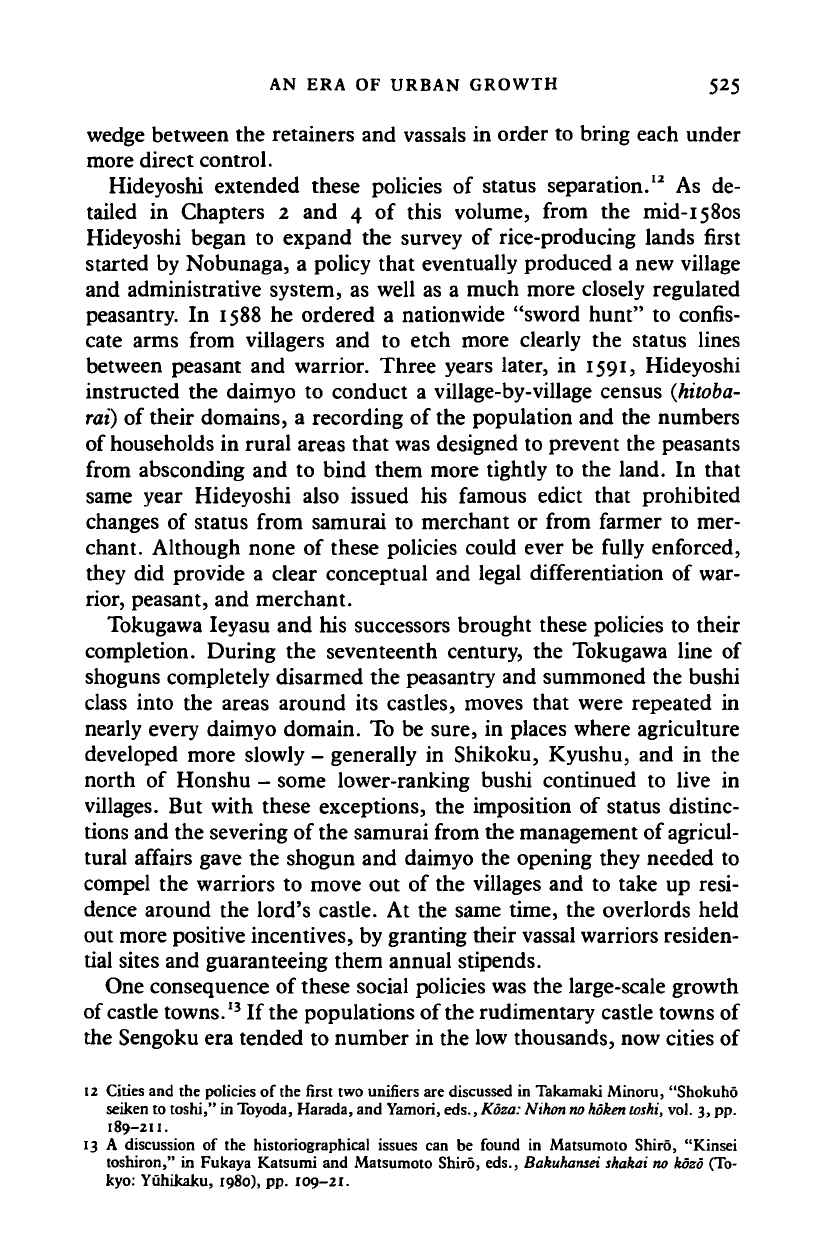
AN ERA OF URBAN GROWTH 525
wedge between the retainers and vassals in order to bring each under
more direct control.
Hideyoshi extended these policies of status separation.
12
As de-
tailed in Chapters 2 and 4 of this volume, from the mid-15 80s
Hideyoshi began to expand the survey of rice-producing lands first
started by Nobunaga, a policy that eventually produced a new village
and administrative system, as well as a much more closely regulated
peasantry. In 1588 he ordered a nationwide "sword hunt" to confis-
cate arms from villagers and to etch more clearly the status lines
between peasant and warrior. Three years later, in 1591, Hideyoshi
instructed the daimyo to conduct a village-by-village census
(hitoba-
rai)
of their domains, a recording of the population and the numbers
of households in rural areas that was designed to prevent the peasants
from absconding and to bind them more tightly to the land. In that
same year Hideyoshi also issued his famous edict that prohibited
changes of status from samurai to merchant or from farmer to mer-
chant. Although none of these policies could ever be fully enforced,
they did provide a clear conceptual and legal differentiation of war-
rior, peasant, and merchant.
Tokugawa Ieyasu and his successors brought these policies to their
completion. During the seventeenth century, the Tokugawa line of
shoguns completely disarmed the peasantry and summoned the bushi
class into the areas around its castles, moves that were repeated in
nearly every daimyo domain. To be sure, in places where agriculture
developed more slowly - generally in Shikoku, Kyushu, and in the
north of Honshu - some lower-ranking bushi continued to live in
villages. But with these exceptions, the imposition of status distinc-
tions and the severing of the samurai from the management of agricul-
tural affairs gave the shogun and daimyo the opening they needed to
compel the warriors to move out of the villages and to take up resi-
dence around the lord's castle. At the same time, the overlords held
out more positive incentives, by granting their vassal warriors residen-
tial sites and guaranteeing them annual stipends.
One consequence of these social policies was the large-scale growth
of
castle
towns.
13
If the populations of the rudimentary castle towns of
the Sengoku era tended to number in the low thousands, now cities of
12 Cities and the policies of the first two unifiers are discussed in Takamaki Minoru, "Shokuho
seiken to toshi," in Toyoda, Harada, and Yamori, eds., Koza: Nikon
no hoken
loshi,
vol. 3, pp.
189-211.
13 A discussion of the historiographical issues can be found in Matsumoto Shiro, "Kinsei
toshiron," in Fukaya Katsumi and Matsumoto Shiro, eds., Bakuhansei shakai no kozo (To-
kyo:
Yuhikaku, 1980), pp. 109-21.
Cambridge Histories Online © Cambridge University Press, 2008
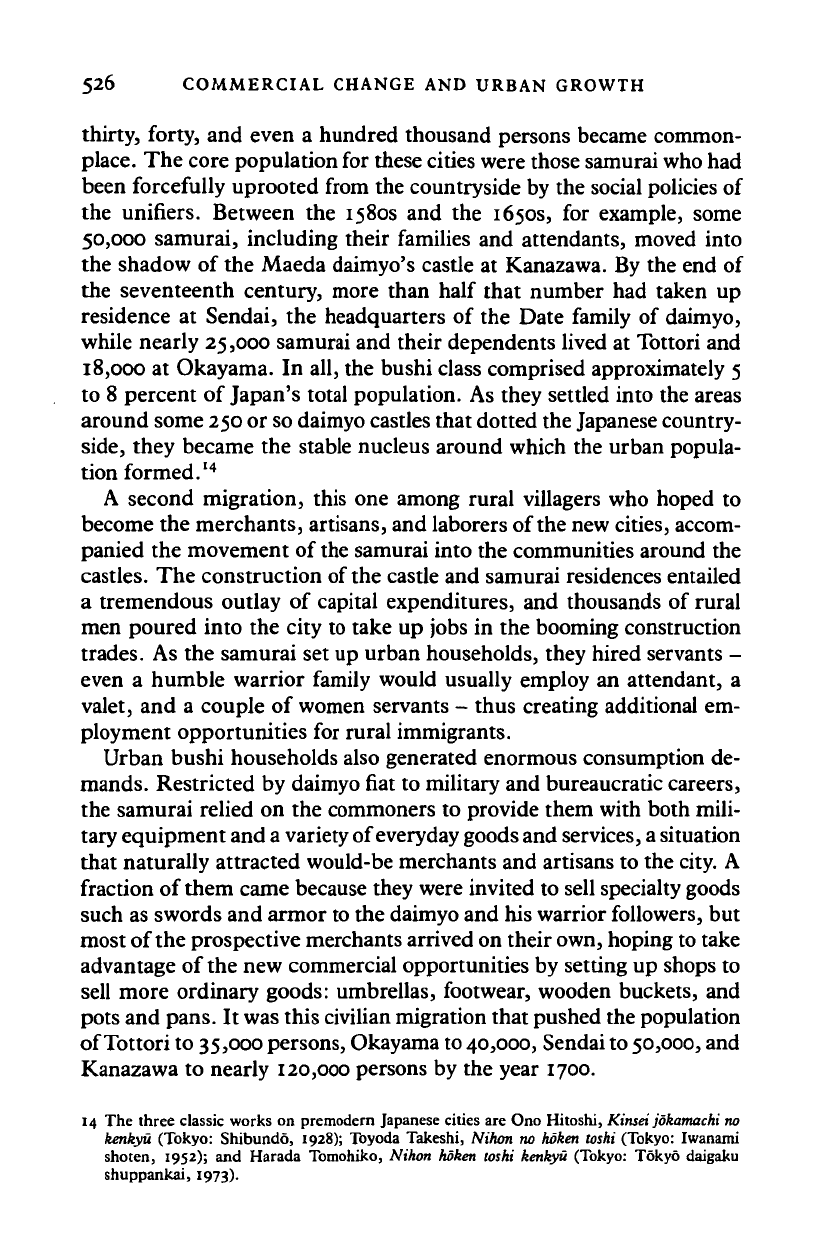
526 COMMERCIAL CHANGE AND URBAN GROWTH
thirty, forty, and even a hundred thousand persons became common-
place. The core population for these cities were those samurai who had
been forcefully uprooted from the countryside by the social policies of
the unifiers. Between the 1580s and the 1650s, for example, some
50,000 samurai, including their families and attendants, moved into
the shadow of the Maeda daimyo's castle at Kanazawa. By the end of
the seventeenth century, more than half that number had taken up
residence at Sendai, the headquarters of the Date family of daimyo,
while nearly 25,000 samurai and their dependents lived at Tottori and
18,000 at Okayama. In all, the bushi class comprised approximately 5
to 8 percent of Japan's total population. As they settled into the areas
around some
250
or so daimyo castles that dotted the Japanese country-
side,
they became the stable nucleus around which the urban popula-
tion formed.'
4
A second migration, this one among rural villagers who hoped to
become the merchants, artisans, and laborers of the new cities, accom-
panied the movement of
the
samurai into the communities around the
castles. The construction of the castle and samurai residences entailed
a tremendous outlay of capital expenditures, and thousands of rural
men poured into the city to take up jobs in the booming construction
trades. As the samurai set up urban households, they hired servants -
even a humble warrior family would usually employ an attendant, a
valet, and a couple of women servants - thus creating additional em-
ployment opportunities for rural immigrants.
Urban bushi households also generated enormous consumption de-
mands. Restricted by daimyo fiat to military and bureaucratic careers,
the samurai relied on the commoners to provide them with both mili-
tary equipment and a variety of everyday goods and services,
a
situation
that naturally attracted would-be merchants and artisans to the city. A
fraction of them came because they were invited to sell specialty goods
such as swords and armor to the daimyo and his warrior followers, but
most of the prospective merchants arrived on their own, hoping to take
advantage of the new commercial opportunities by setting up shops to
sell more ordinary goods: umbrellas, footwear, wooden buckets, and
pots and pans. It was this civilian migration that pushed the population
of Tottori to 35,000 persons, Okayama
to
40,000,
Sendai to
50,000,
and
Kanazawa to nearly 120,000 persons by the year 1700.
14 The three classic works on premodern Japanese cities are Ono Hitoshi, Kinsei
jokamachi
no
kenkyu (Tokyo: Shibundo, 1928); Toyoda Takeshi, Nihon no hoken toshi (Tokyo: Iwanami
shoten, 1952); and Harada Tomohiko, Nihon hoken toshi kenkyu (Tokyo: Tokyo daigaku
shuppankai, 1973).
Cambridge Histories Online © Cambridge University Press, 2008
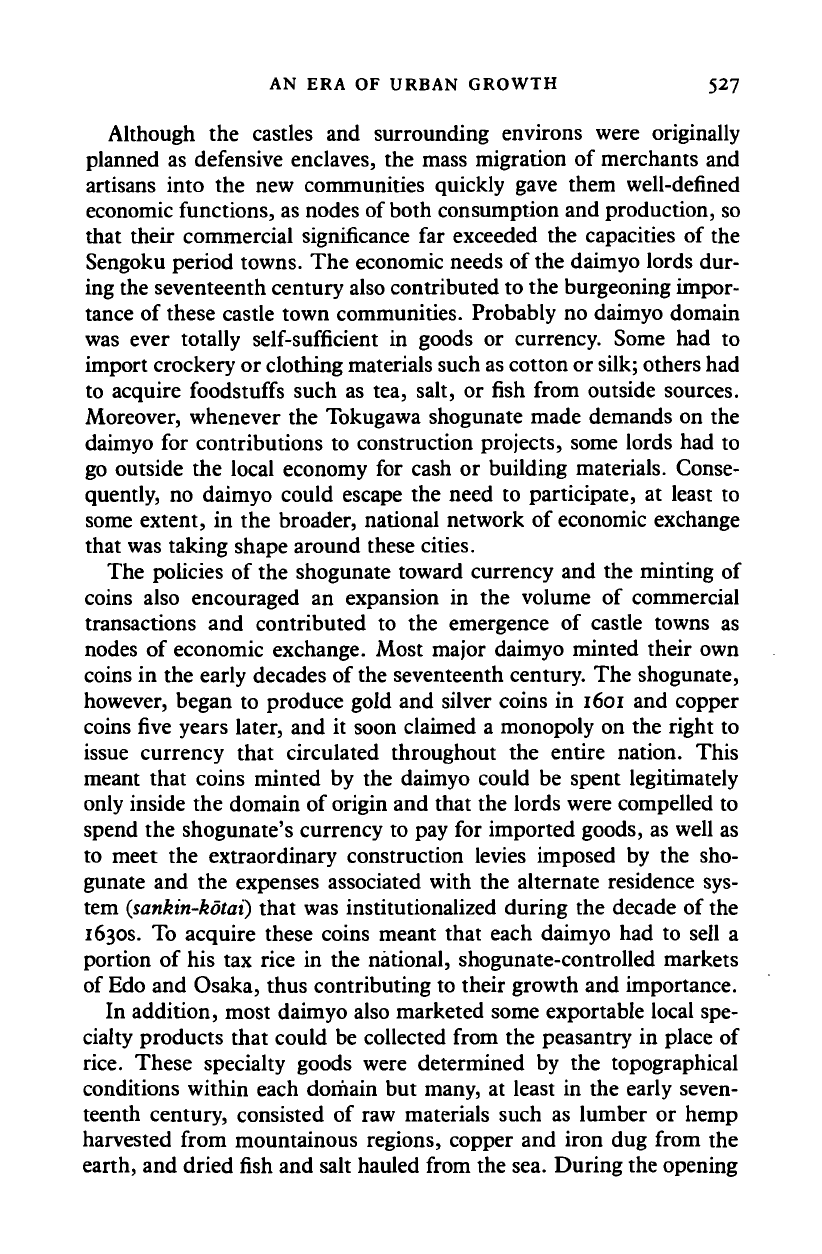
AN ERA OF URBAN GROWTH 527
Although the castles and surrounding environs were originally
planned as defensive enclaves, the mass migration of merchants and
artisans into the new communities quickly gave them well-defined
economic functions, as nodes of both consumption and production, so
that their commercial significance far exceeded the capacities of the
Sengoku period towns. The economic needs of the daimyo lords dur-
ing the seventeenth century also contributed to the burgeoning impor-
tance of these castle town communities. Probably no daimyo domain
was ever totally self-sufficient in goods or currency. Some had to
import crockery or clothing materials such as cotton or silk; others had
to acquire foodstuffs such as tea, salt, or fish from outside sources.
Moreover, whenever the Tokugawa shogunate made demands on the
daimyo for contributions to construction projects, some lords had to
go outside the local economy for cash or building materials. Conse-
quently, no daimyo could escape the need to participate, at least to
some extent, in the broader, national network of economic exchange
that was taking shape around these cities.
The policies of the shogunate toward currency and the minting of
coins also encouraged an expansion in the volume of commercial
transactions and contributed to the emergence of castle towns as
nodes of economic exchange. Most major daimyo minted their own
coins in the early decades of the seventeenth century. The shogunate,
however, began to produce gold and silver coins in 1601 and copper
coins five years later, and it soon claimed a monopoly on the right to
issue currency that circulated throughout the entire nation. This
meant that coins minted by the daimyo could be spent legitimately
only inside the domain of origin and that the lords were compelled to
spend the shogunate's currency to pay for imported goods, as well as
to meet the extraordinary construction levies imposed by the sho-
gunate and the expenses associated with the alternate residence sys-
tem
(sankin-kotai)
that was institutionalized during the decade of the
1630s. To acquire these coins meant that each daimyo had to sell a
portion of his tax rice in the national, shogunate-controlled markets
of Edo and Osaka, thus contributing to their growth and importance.
In addition, most daimyo also marketed some exportable local spe-
cialty products that could be collected from the peasantry in place of
rice.
These specialty goods were determined by the topographical
conditions within each domain but many, at least in the early seven-
teenth century, consisted of raw materials such as lumber or hemp
harvested from mountainous regions, copper and iron dug from the
earth, and dried fish and salt hauled from the sea. During the opening
Cambridge Histories Online © Cambridge University Press, 2008
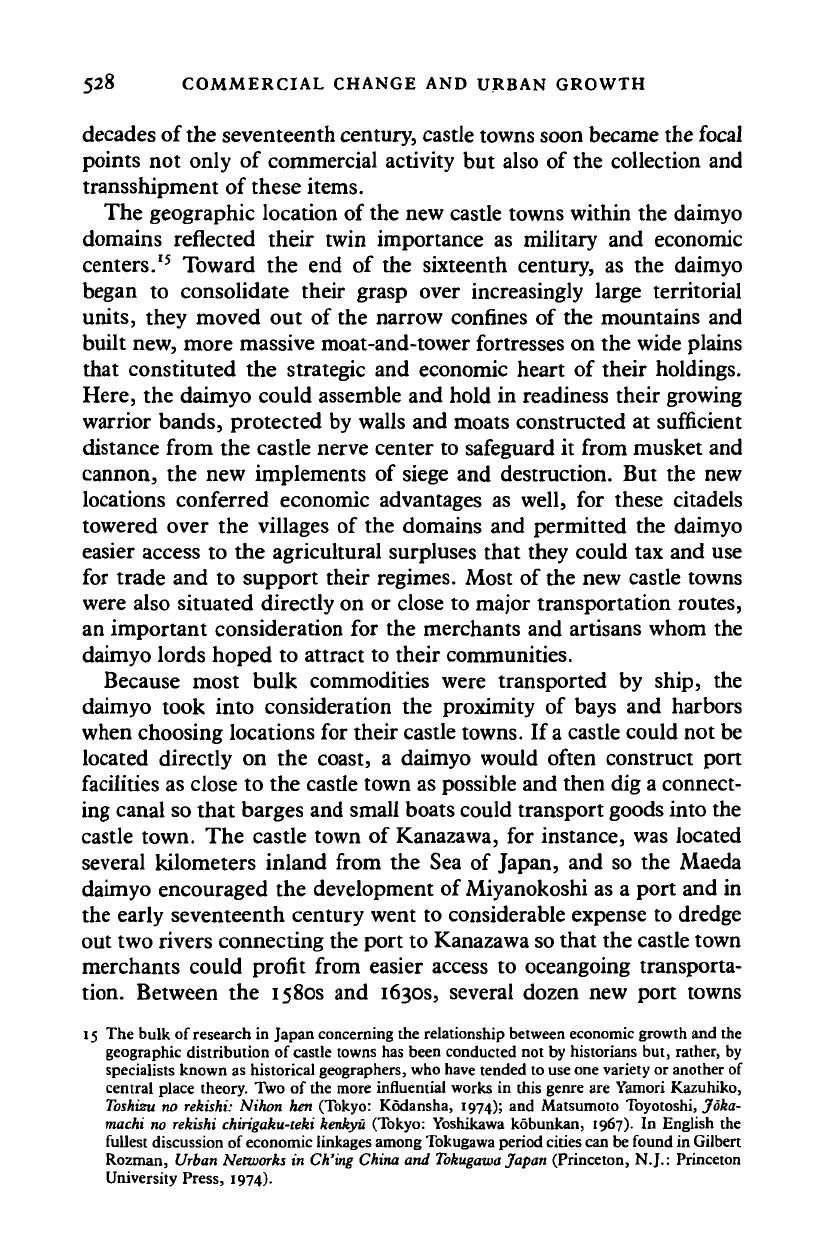
528 COMMERCIAL CHANGE AND URBAN GROWTH
decades of the seventeenth century, castle towns soon became the focal
points not only of commercial activity but also of the collection and
transshipment of these items.
The geographic location of the new castle towns within the daimyo
domains reflected their twin importance as military and economic
centers.
15
Toward the end of the sixteenth century, as the daimyo
began to consolidate their grasp over increasingly large territorial
units,
they moved out of the narrow confines of the mountains and
built new, more massive moat-and-tower fortresses on the wide plains
that constituted the strategic and economic heart of their holdings.
Here, the daimyo could assemble and hold in readiness their growing
warrior bands, protected by walls and moats constructed at sufficient
distance from the castle nerve center to safeguard it from musket and
cannon, the new implements of siege and destruction. But the new
locations conferred economic advantages as well, for these citadels
towered over the villages of the domains and permitted the daimyo
easier access to the agricultural surpluses that they could tax and use
for trade and to support their regimes. Most of the new castle towns
were also situated directly on or close to major transportation routes,
an important consideration for the merchants and artisans whom the
daimyo lords hoped to attract to their communities.
Because most bulk commodities were transported by ship, the
daimyo took into consideration the proximity of bays and harbors
when choosing locations for their castle towns. If
a
castle could not be
located directly on the coast, a daimyo would often construct port
facilities as close to the castle town as possible and then dig a connect-
ing canal so that barges and small boats could transport goods into the
castle town. The castle town of Kanazawa, for instance, was located
several kilometers inland from the Sea of Japan, and so the Maeda
daimyo encouraged the development of Miyanokoshi as a port and in
the early seventeenth century went to considerable expense to dredge
out two rivers connecting the port to Kanazawa so that the castle town
merchants could profit from easier access to oceangoing transporta-
tion. Between the 1580s and 1630s, several dozen new port towns
15 The bulk of research in Japan concerning the relationship between economic growth and the
geographic distribution of castle towns has been conducted not by historians but, rather, by
specialists known as historical geographers, who have tended to use one variety or another of
central place theory. Two of the more influential works in this genre are Yamori Kazuhiko,
Toshizu no rekishi: Nihon hen (Tokyo: Kodansha, 1974); and Matsumoto Toyotoshi, Joka-
machi no rekishi chirigaku-teki kenkyu (Tokyo: Yoshikawa kobunkan, 1967). In English the
fullest discussion of economic linkages among Tokugawa period cities can be found in Gilbert
Rozman, Urban Networks in Ch'ing China and
Tokugawa
Japan (Princeton, N.J.: Princeton
University Press, 1974).
Cambridge Histories Online © Cambridge University Press, 2008
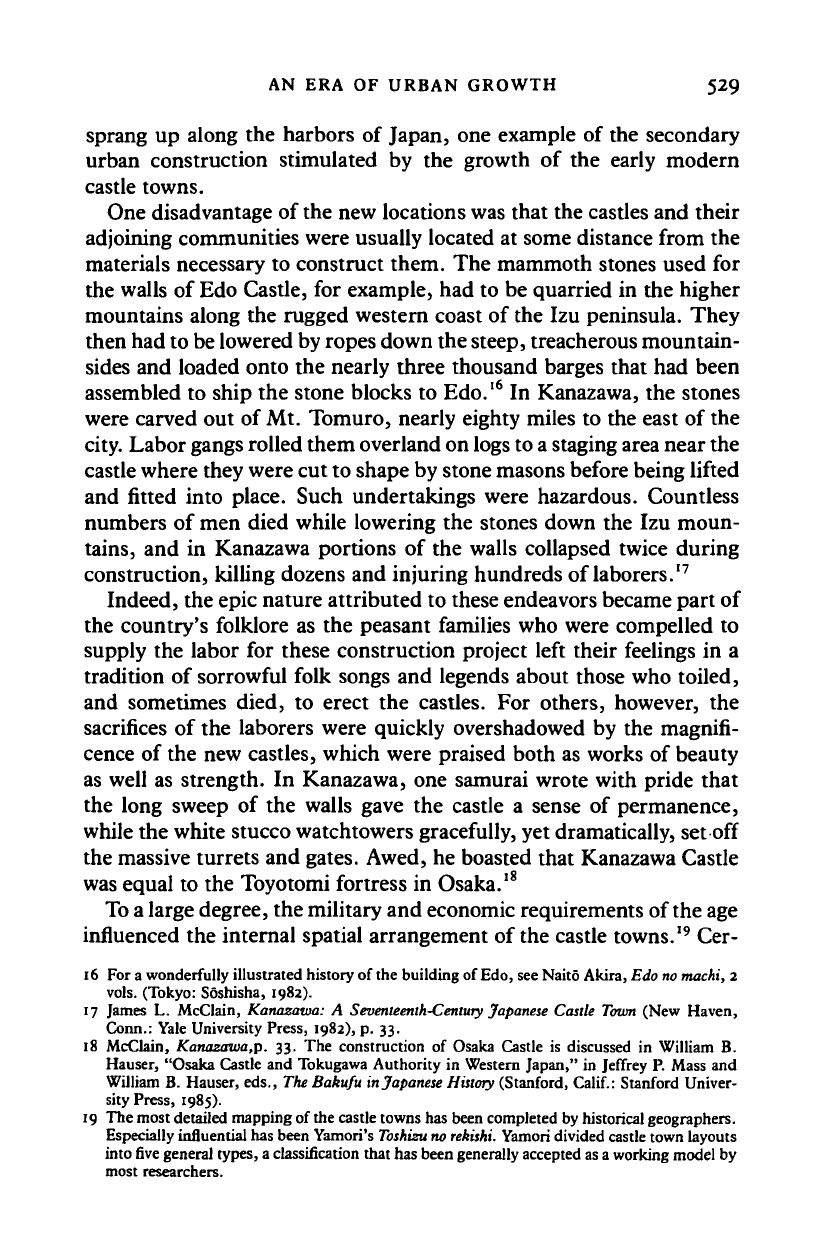
AN ERA OF URBAN GROWTH 529
sprang up along the harbors of Japan, one example of the secondary
urban construction stimulated by the growth of the early modern
castle towns.
One disadvantage of the new locations was that the castles and their
adjoining communities were usually located at some distance from the
materials necessary to construct them. The mammoth stones used for
the walls of Edo Castle, for example, had to be quarried in the higher
mountains along the rugged western coast of the Izu peninsula. They
then had to be lowered by ropes down the steep, treacherous mountain-
sides and loaded onto the nearly three thousand barges that had been
assembled to ship the stone blocks to Edo.
16
In Kanazawa, the stones
were carved out of
Alt.
Tomuro, nearly eighty miles to the east of the
city. Labor
gangs
rolled them overland on logs to
a
staging area near the
castle where they were cut to shape by stone masons before being lifted
and fitted into place. Such undertakings were hazardous. Countless
numbers of men died while lowering the stones down the Izu moun-
tains,
and in Kanazawa portions of the walls collapsed twice during
construction, killing dozens and injuring hundreds of laborers.
17
Indeed, the epic nature attributed to these endeavors became part of
the country's folklore as the peasant families who were compelled to
supply the labor for these construction project left their feelings in a
tradition of sorrowful folk songs and legends about those who toiled,
and sometimes died, to erect the castles. For others, however, the
sacrifices of the laborers were quickly overshadowed by the magnifi-
cence of the new castles, which were praised both as works of beauty
as well as strength. In Kanazawa, one samurai wrote with pride that
the long sweep of the walls gave the castle a sense of permanence,
while the white stucco watchtowers gracefully, yet dramatically, set off
the massive turrets and gates. Awed, he boasted that Kanazawa Castle
was equal to the Toyotomi fortress in Osaka.'
8
To a
large degree, the military and economic requirements of the age
influenced the internal spatial arrangement of the castle towns.
19
Cer-
16 For a wonderfully illustrated history of the building of Edo, see Naito Akira, Edo
no
machi, 2
vols.
(Tokyo: Soshisha, 1982).
17 James L. McClain, Kanazawa: A
Seventeenth-Century
Japanese Castle Town (New Haven,
Conn.: Yale University Press, 1982), p. 33.
18 McClain, Kanazawa,p. 33. The construction of Osaka Castle is discussed in William B.
Hauser, "Osaka Castle and Tokugawa Authority in Western Japan," in Jeffrey P. Mass and
William B. Hauser, eds., The Bakufu
in
Japanese History (Stanford,
Calif.:
Stanford Univer-
sity Press, 1985).
19 The most detailed mapping of the castle towns has been completed by historical geographers.
Especially influential has been Yamori's
Toshizu no
rekishi.
Yamori divided castle town layouts
into five general types, a classification that has been generally accepted as a working model by
most researchers.
Cambridge Histories Online © Cambridge University Press, 2008
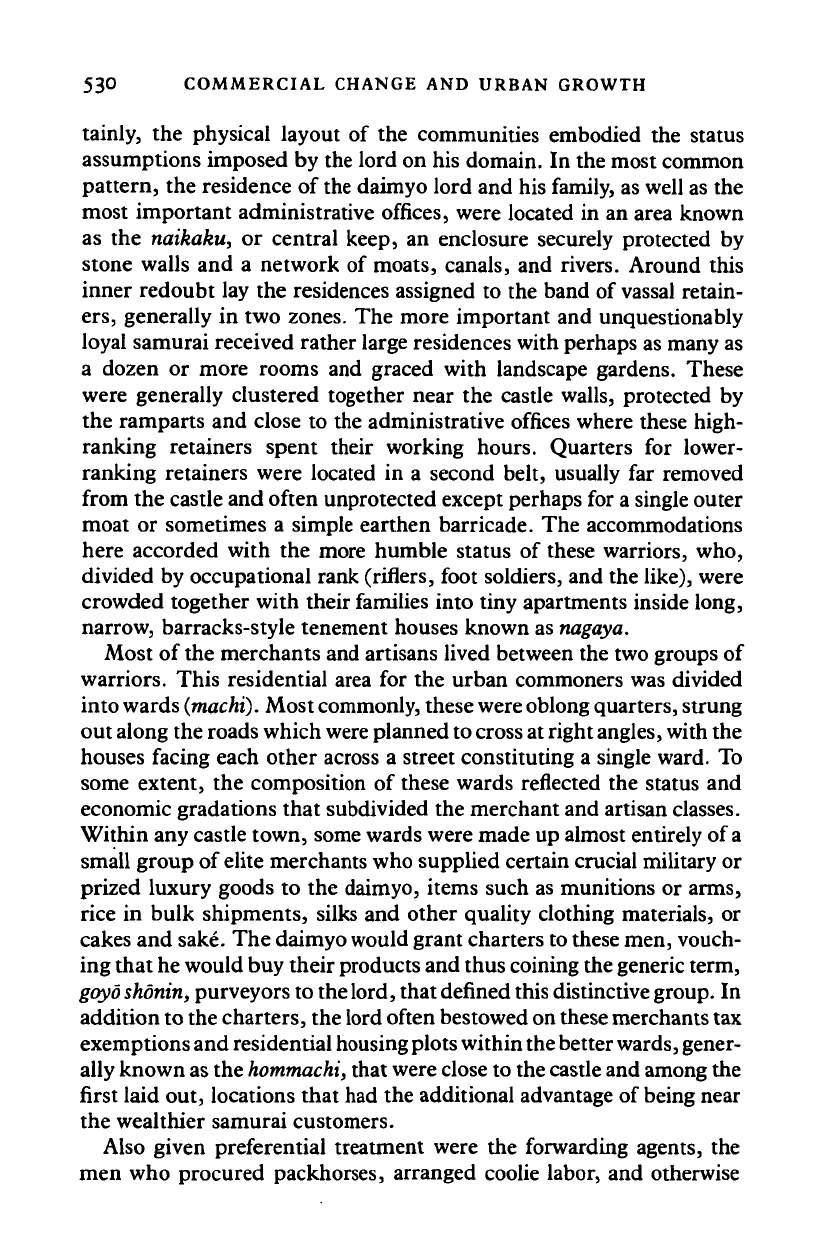
53° COMMERCIAL CHANGE AND URBAN GROWTH
tainly, the physical layout of the communities embodied the status
assumptions imposed by the lord on his domain. In the most common
pattern, the residence of the daimyo lord and his family, as well as the
most important administrative offices, were located in an area known
as the naikaku, or central keep, an enclosure securely protected by
stone walls and a network of moats, canals, and rivers. Around this
inner redoubt lay the residences assigned to the band of vassal retain-
ers,
generally in two zones. The more important and unquestionably
loyal samurai received rather large residences with perhaps as many as
a dozen or more rooms and graced with landscape gardens. These
were generally clustered together near the castle walls, protected by
the ramparts and close to the administrative offices where these high-
ranking retainers spent their working hours. Quarters for lower-
ranking retainers were located in a second belt, usually far removed
from the castle and often unprotected except perhaps for a single outer
moat or sometimes a simple earthen barricade. The accommodations
here accorded with the more humble status of these warriors, who,
divided by occupational rank (riflers, foot soldiers, and the like), were
crowded together with their families into tiny apartments inside long,
narrow, barracks-style tenement houses known as
nagaya.
Most of the merchants and artisans lived between the two groups of
warriors. This residential area for the urban commoners was divided
into wards
(machi).
Most
commonly,
these were oblong quarters, strung
out along the roads which
were
planned to cross at right
angles,
with the
houses facing each other across a street constituting a single ward. To
some extent, the composition of these wards reflected the status and
economic gradations that subdivided the merchant and artisan classes.
Within any castle town, some wards were made up almost entirely of a
small group of elite merchants who supplied certain crucial military or
prized luxury goods to the daimyo, items such as munitions or arms,
rice in bulk shipments, silks and other quality clothing materials, or
cakes and sake. The daimyo would grant charters to these men, vouch-
ing that he would buy their products and thus coining the generic term,
gqyo
shonin,
purveyors to the
lord,
that defined this distinctive
group.
In
addition to the
charters,
the lord often bestowed on these merchants tax
exemptions and residential housing plots within
the
better
wards,
gener-
ally known as the
hommachi,
that were close to the castle and among the
first laid out, locations that had the additional advantage of being near
the wealthier samurai customers.
Also given preferential treatment were the forwarding agents, the
men who procured packhorses, arranged coolie labor, and otherwise
Cambridge Histories Online © Cambridge University Press, 2008
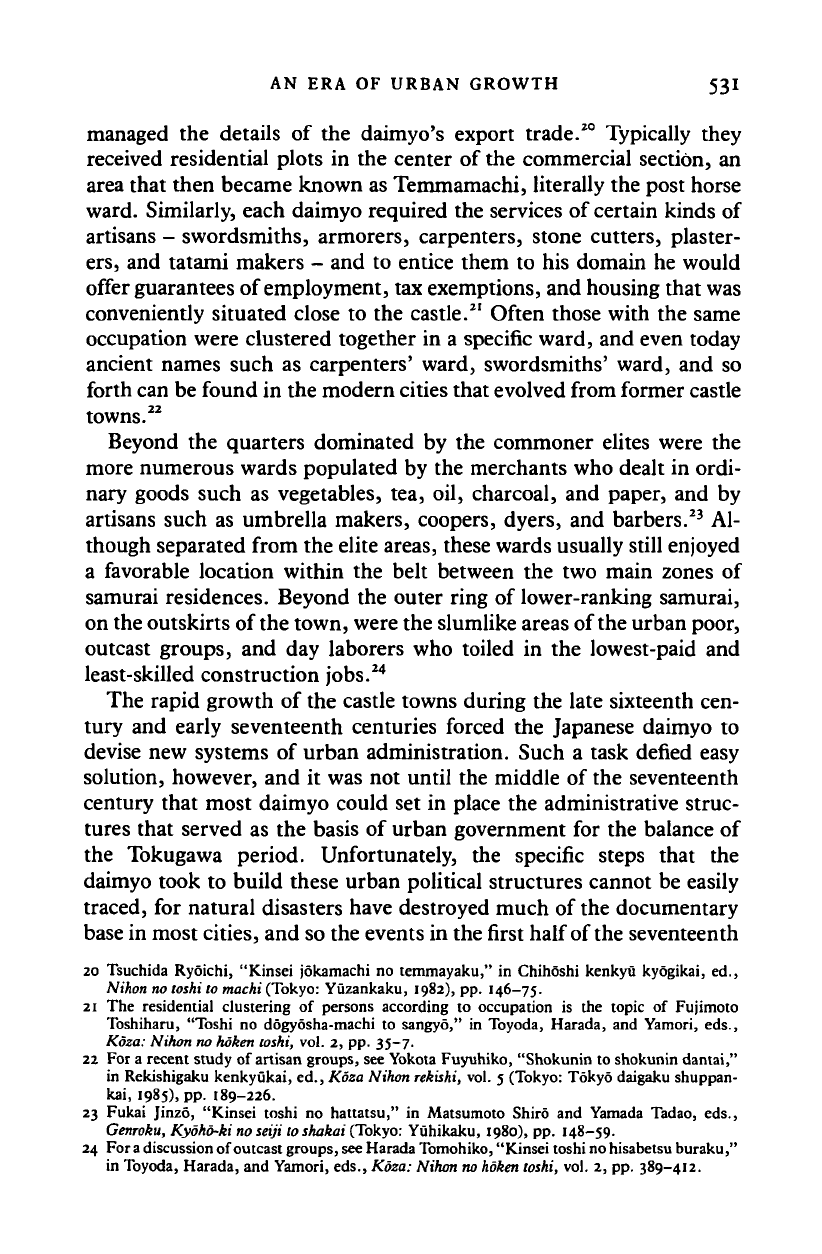
AN ERA OF URBAN GROWTH 531
managed the details of the daimyo's export trade.
20
Typically they
received residential plots in the center of the commercial section, an
area that then became known as Temmamachi, literally the post horse
ward. Similarly, each daimyo required the services of certain kinds of
artisans - swordsmiths, armorers, carpenters, stone cutters, plaster-
ers,
and tatami makers - and to entice them to his domain he would
offer guarantees of employment, tax exemptions, and housing that was
conveniently situated close to the castle.
21
Often those with the same
occupation were clustered together in a specific ward, and even today
ancient names such as carpenters' ward, swordsmiths' ward, and so
forth can be found in the modern cities that evolved from former castle
towns.
22
Beyond the quarters dominated by the commoner elites were the
more numerous wards populated by the merchants who dealt in ordi-
nary goods such as vegetables, tea, oil, charcoal, and paper, and by
artisans such as umbrella makers, coopers, dyers, and barbers.
23
Al-
though separated from the elite areas, these wards usually still enjoyed
a favorable location within the belt between the two main zones of
samurai residences. Beyond the outer ring of lower-ranking samurai,
on the outskirts of the town, were the slumlike areas of the urban poor,
outcast groups, and day laborers who toiled in the lowest-paid and
least-skilled construction jobs.
24
The rapid growth of the castle towns during the late sixteenth cen-
tury and early seventeenth centuries forced the Japanese daimyo to
devise new systems of urban administration. Such a task defied easy
solution, however, and it was not until the middle of the seventeenth
century that most daimyo could set in place the administrative struc-
tures that served as the basis of urban government for the balance of
the Tokugawa period. Unfortunately, the specific steps that the
daimyo took to build these urban political structures cannot be easily
traced, for natural disasters have destroyed much of the documentary
base in most cities, and so the events in the first half of
the
seventeenth
20 Tsuchida Ryoichi, "Kinsei jokamachi no temmayaku," in Chihoshi kenkyu kyogikai, ed.,
Nihon no toshi to machi (Tokyo: Yuzankaku, 1982), pp. 146-75.
21 The residential clustering of persons according to occupation is the topic of Fujimoto
Toshiharu, "Toshi no dogyosha-machi to sangyo," in Toyoda, Harada, and Yamori, eds.,
Koza: Nikon no koken toski, vol. 2, pp. 35-7.
22 For a recent study of artisan groups, see Yokota Fuyuhiko, "Shokunin to shokunin dantai,"
in Rekishigaku kenkyOkai, ed., Koza Nihon rekishi, vol. 5 (Tokyo: Tokyo daigaku shuppan-
kai, 1985), pp. 189-226.
23 Fukai Jinzo, "Kinsei toshi no hattatsu," in Matsumoto Shiro and Yamada Tadao, eds.,
Genroku,
Kyoho-ki no seiji to shakai (Tokyo: Yuhikaku, 1980), pp. 148-59.
24 For
a
discussion of outcast groups, see Harada Tomohiko, "Kinsei toshi no hisabetsu buraku,"
in Toyoda, Harada, and Yamori, eds., Koza: Nihon
no hbken
toshi, vol. 2, pp. 389-412.
Cambridge Histories Online © Cambridge University Press, 2008
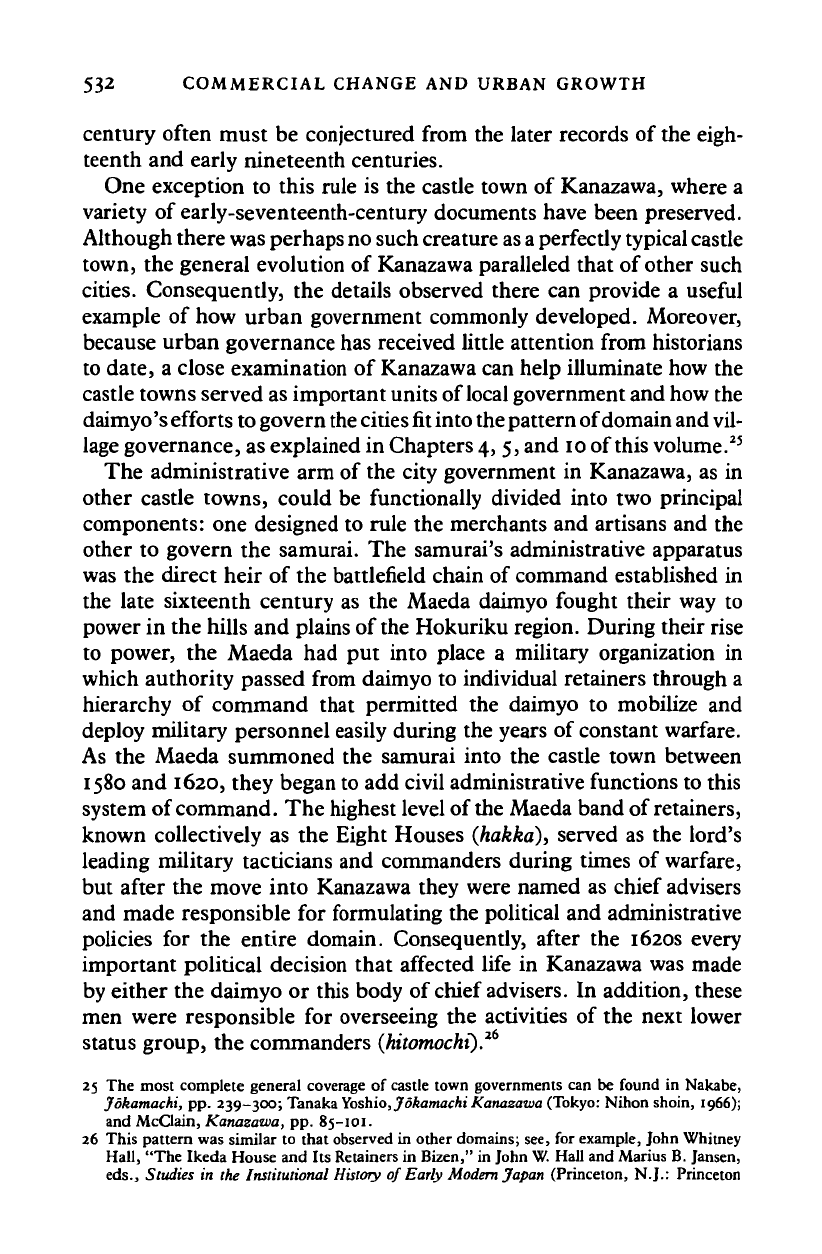
532 COMMERCIAL CHANGE AND URBAN GROWTH
century often must be conjectured from the later records of the eigh-
teenth and early nineteenth centuries.
One exception to this rule is the castle town of Kanazawa, where a
variety of early-seventeenth-century documents have been preserved.
Although there was perhaps
no
such creature
as a
perfectly typical castle
town, the general evolution of Kanazawa paralleled that of other such
cities.
Consequently, the details observed there can provide a useful
example of how urban government commonly developed. Moreover,
because urban governance has received little attention from historians
to date, a close examination of Kanazawa can help illuminate how the
castle towns served as important units of local government and how the
daimyo's efforts to govern
the cities
fit
into
the
pattern of domain and
vil-
lage governance, as explained in Chapters 4, 5, and
10
of this volume.
25
The administrative arm of the city government in Kanazawa, as in
other castle towns, could be functionally divided into two principal
components: one designed to rule the merchants and artisans and the
other to govern the samurai. The samurai's administrative apparatus
was the direct heir of the battlefield chain of command established in
the late sixteenth century as the Maeda daimyo fought their way to
power in the hills and plains of
the
Hokuriku region. During their rise
to power, the Maeda had put into place a military organization in
which authority passed from daimyo to individual retainers through a
hierarchy of command that permitted the daimyo to mobilize and
deploy military personnel easily during the years of constant warfare.
As the Maeda summoned the samurai into the castle town between
1580 and 1620, they began to add civil administrative functions to this
system of command. The highest level of
the
Maeda band of retainers,
known collectively as the Eight Houses (hakka), served as the lord's
leading military tacticians and commanders during times of warfare,
but after the move into Kanazawa they were named as chief advisers
and made responsible for formulating the political and administrative
policies for the entire domain. Consequently, after the 1620s every
important political decision that affected life in Kanazawa was made
by either the daimyo or this body of chief
advisers.
In addition, these
men were responsible for overseeing the activities of the next lower
status group, the commanders
(hitomochi).
16
25 The most complete general coverage of castle town governments can be found in Nakabe,
Jokamachi, pp. 239-300; Tanaka
Yoshio,
Jokamachi Kanazawa (Tokyo: Nihon shoin, 1966);
and McClain, Kanazawa, pp. 85-101.
26 This pattern was similar to that observed in other domains; see, for example, John Whitney
Hall, "The Ikeda House and Its Retainers in Bizen," in John W. Hall and Marius B. Jansen,
eds.,
Studies in the Institutional History of Early Modem Japan (Princeton, N.J.: Princeton
Cambridge Histories Online © Cambridge University Press, 2008
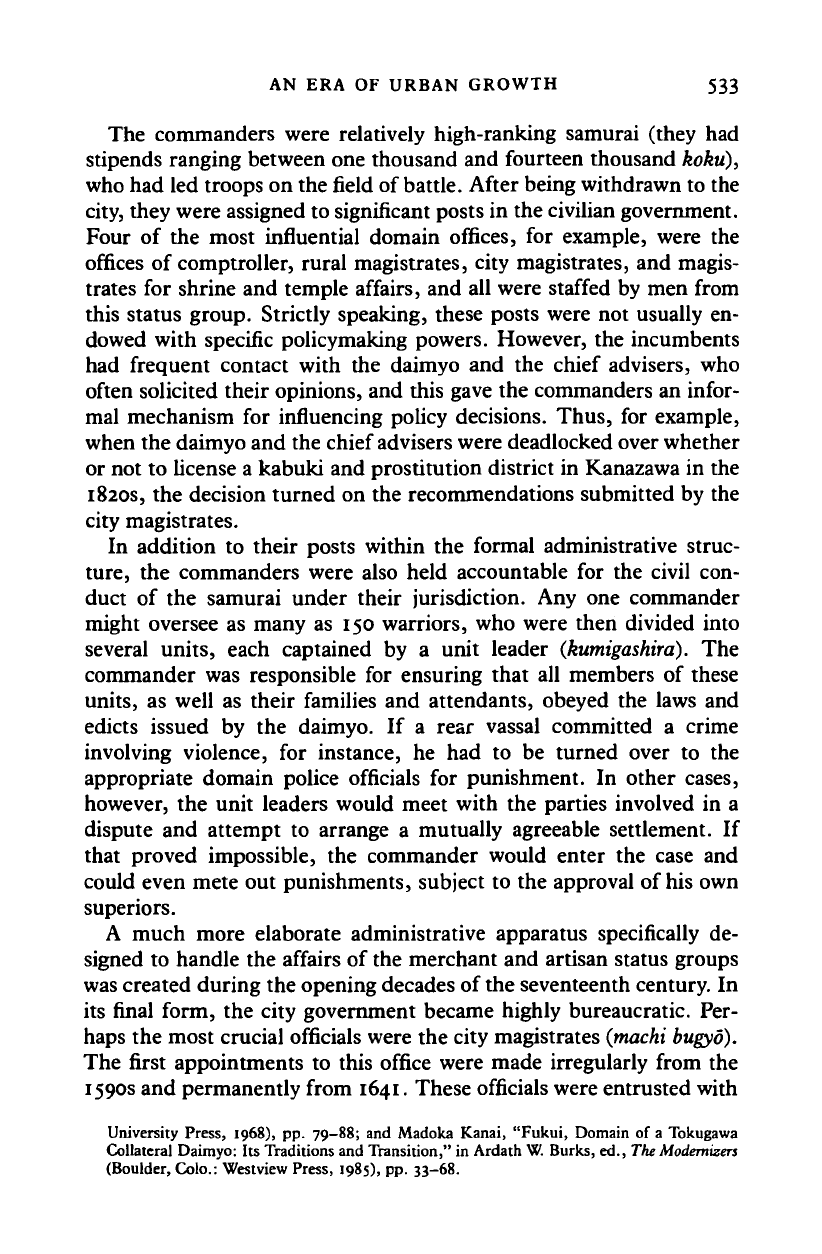
AN ERA OF URBAN GROWTH 533
The commanders were relatively high-ranking samurai (they had
stipends ranging between one thousand and fourteen thousand koku),
who had led troops on the
field
of
battle.
After being withdrawn to the
city, they were assigned to significant posts in the civilian government.
Four of the most influential domain offices, for example, were the
offices of comptroller, rural magistrates, city magistrates, and magis-
trates for shrine and temple affairs, and all were staffed by men from
this status group. Strictly speaking, these posts were not usually en-
dowed with specific policymaking powers. However, the incumbents
had frequent contact with the daimyo and the chief advisers, who
often solicited their opinions, and this gave the commanders an infor-
mal mechanism for influencing policy decisions. Thus, for example,
when the daimyo and the chief advisers were deadlocked over whether
or not to license a kabuki and prostitution district in Kanazawa in the
1820s, the decision turned on the recommendations submitted by the
city magistrates.
In addition to their posts within the formal administrative struc-
ture,
the commanders were also held accountable for the civil con-
duct of the samurai under their jurisdiction. Any one commander
might oversee as many as 150 warriors, who were then divided into
several units, each captained by a unit leader
(kumigashira).
The
commander was responsible for ensuring that all members of these
units,
as well as their families and attendants, obeyed the laws and
edicts issued by the daimyo. If a rear vassal committed a crime
involving violence, for instance, he had to be turned over to the
appropriate domain police officials for punishment. In other cases,
however, the unit leaders would meet with the parties involved in a
dispute and attempt to arrange a mutually agreeable settlement. If
that proved impossible, the commander would enter the case and
could even mete out punishments, subject to the approval of his own
superiors.
A much more elaborate administrative apparatus specifically de-
signed to handle the affairs of the merchant and artisan status groups
was created during the opening decades of the seventeenth century. In
its final form, the city government became highly bureaucratic. Per-
haps the most crucial officials were the city magistrates
(machi
bugyo).
The first appointments to this office were made irregularly from the
1590s and permanently from
1641.
These officials were entrusted with
University Press, 1968), pp. 79-88; and Madoka Kanai, "Fukui, Domain of a Tokugawa
Collateral Daimyo: Its Traditions and Transition," in Ardath W. Burks, ed., The
Modernize™
(Boulder, Colo.: Westview Press, 1985), pp. 33-68.
Cambridge Histories Online © Cambridge University Press, 2008
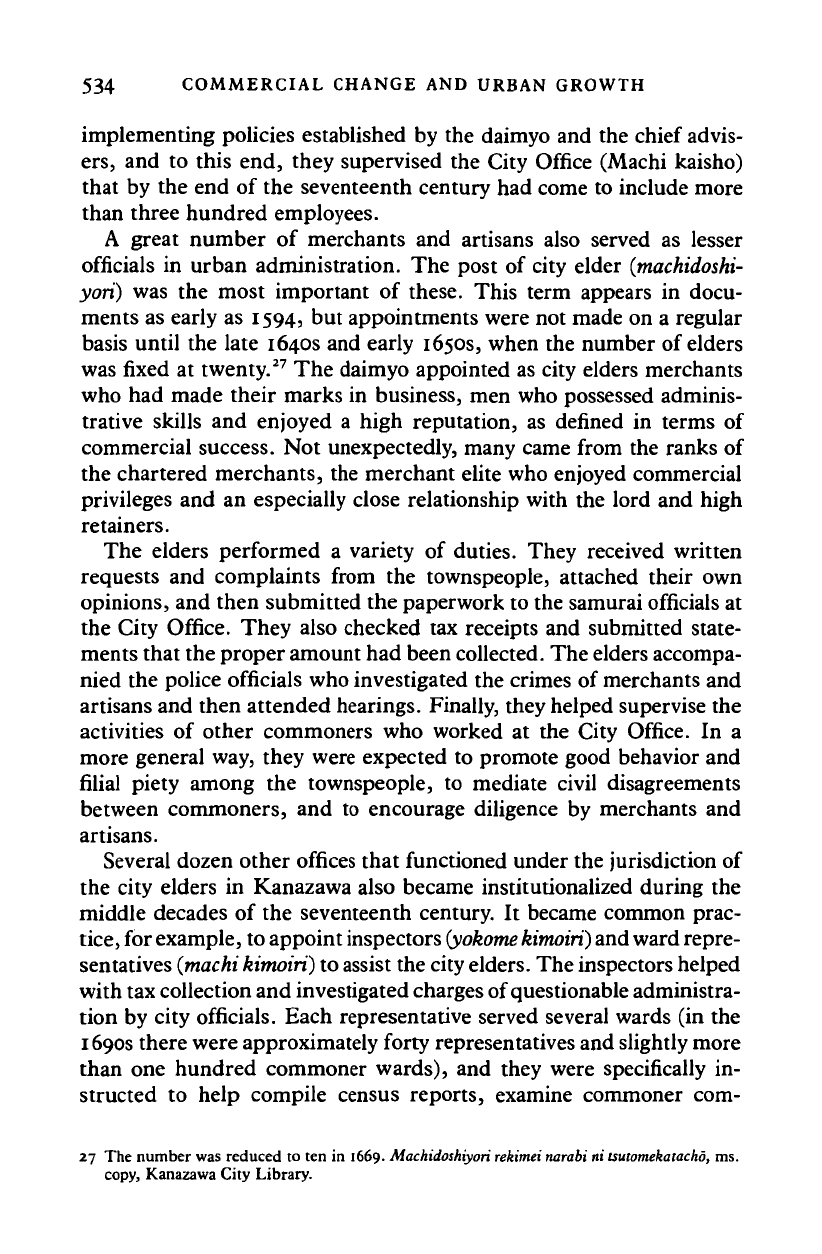
534 COMMERCIAL CHANGE AND URBAN GROWTH
implementing policies established
by the
daimyo
and the
chief advis-
ers,
and
to
this
end,
they supervised
the
City Office (Machi kaisho)
that
by the
end
of
the seventeenth century had come
to
include more
than three hundred employees.
A great number
of
merchants
and
artisans also served
as
lesser
officials
in
urban administration.
The
post
of
city elder
(tnachidoshi-
yori)
was the
most important
of
these. This term appears
in
docu-
ments as early as 1594, but appointments were not made
on a
regular
basis until
the
late 1640s and early 1650s, when the number
of
elders
was fixed
at
twenty.
27
The daimyo appointed as city elders merchants
who
had
made their marks
in
business, men who possessed adminis-
trative skills
and
enjoyed
a
high reputation,
as
defined
in
terms
of
commercial success.
Not
unexpectedly, many came from
the
ranks
of
the chartered merchants, the merchant elite who enjoyed commercial
privileges
and an
especially close relationship with
the
lord
and
high
retainers.
The elders performed
a
variety
of
duties. They received written
requests
and
complaints from
the
townspeople, attached their
own
opinions, and then submitted the paperwork to the samurai officials at
the City Office. They also checked
tax
receipts
and
submitted state-
ments that the proper amount had been collected. The elders accompa-
nied
the
police officials who investigated the crimes of merchants and
artisans and then attended hearings. Finally, they helped supervise
the
activities
of
other commoners
who
worked
at
the
City Office.
In a
more general way, they were expected
to
promote good behavior and
filial piety among
the
townspeople,
to
mediate civil disagreements
between commoners,
and
to
encourage diligence
by
merchants
and
artisans.
Several dozen other offices that functioned under the jurisdiction of
the city elders
in
Kanazawa also became institutionalized during
the
middle decades
of
the seventeenth century.
It
became common prac-
tice,
for
example,
to appoint inspectors
(yokome kimoiri)
and ward repre-
sentatives
(machi kimoiri)
to assist the city
elders.
The inspectors helped
with tax collection and investigated charges of questionable administra-
tion
by
city officials. Each representative served several wards
(in the
1690s there were approximately forty representatives and slightly more
than
one
hundred commoner wards),
and
they were specifically
in-
structed
to
help compile census reports, examine commoner
com-
27
The
number was reduced
to ten
in
1669. Machidoshiyori rekimei narabi ni tsutomekatacho,
ms.
copy, Kanazawa City Library.
Cambridge Histories Online © Cambridge University Press, 2008
